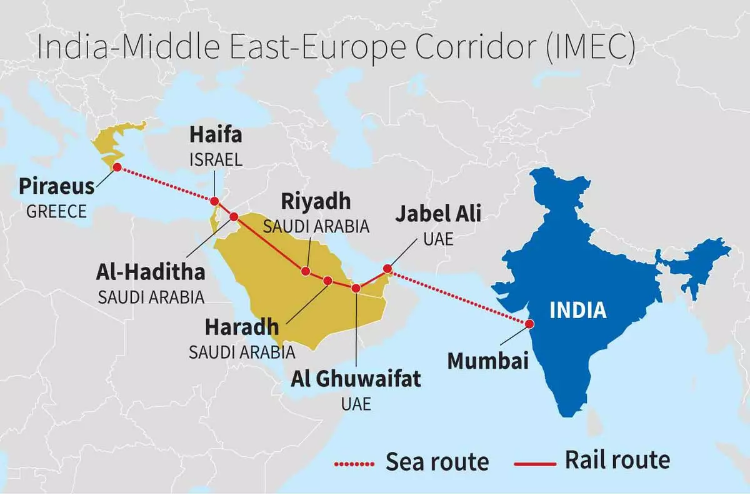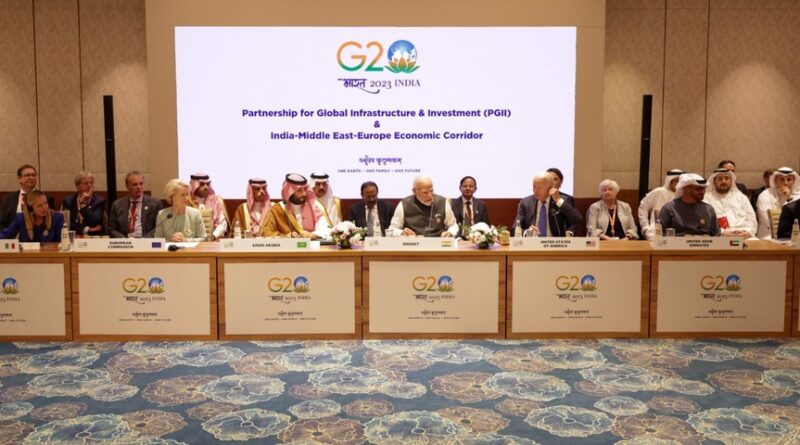Unlocking Geopolitical Shifts: The India – Middle East – Europe Economic Corridor (IMEC)
In a historic development with far-reaching geopolitical implications, several nations spanning continents have come together to announce the creation of the India – Middle East – Europe Economic Corridor (IMEC). This Memorandum of Understanding (MOU) was unveiled on the sidelines of the G20 summit in New Delhi by the government of India, Middle Eastern countries, Europe, and the United States, marking a significant milestone in global economic and political dynamics.
Significance of the IMEC Project
IMEC is poised to stimulate economic growth and cooperation among countries in the Indian Ocean region, the Indian subcontinent, the Middle East, and Europe. It has the potential to significantly boost trade and economic development in these areas. For instance, the destinations for India’s engineering exports are primarily the Middle East and Europe. These exports will receive a significant boost. Moreover, this offers India the opportunity to create green hydrogen and green ammonia hubs near the coasts, supplying these commodities via shipping and rail networks to the Middle East and eventually Europe. Analysts project that the corridor will not only be efficient and cost-effective but will also enhance competitiveness. IMEC comprises two distinct corridors: the east corridor linking India to the Arabian Gulf and the northern corridor connecting the Arabian Gulf to Europe. This includes a comprehensive railway network designed to offer reliability and cost-effectiveness, complementing existing maritime and road routes. Additionally, the corridor will feature infrastructure for electricity and digital connectivity, as well as pipelines for clean hydrogen exports. This will secure regional supply chains, improve trade accessibility, and streamline trade operations, all aimed at increasing economic efficiency, reducing costs, and fostering economic unity among participating nations. This, in turn, will generate employment opportunities and contribute to the global goal of lowering greenhouse gas emissions.
IMEC: A Counter to China’s BRI
The India-Middle East corridor, or IMEC, presents a possible challenge to China’s Belt and Road Initiative (BRI) as it has the potential to divert the supply chain from China to Indian, Arab, and European conglomerates. IMEC is a strategic counter to China’s BRI project, which has faced criticism for creating a “debt trap” and diminishing the sovereignty of member countries. It serves as a response to China’s expansionist policies. China’s influence in the Middle East has been on the rise, with recent deals brokered between China and Saudi Arabia and the UAE, both of which are traditional allies of the United States. A significant distinction exists between IMEC and BRI: the Partnership for Global Infrastructure Investment (PGII) is a multilateral funding initiative with public and private partnerships, whereas BRI relies on direct funding from Chinese development banks and is executed solely by Chinese companies.

Challenges and Considerations
While IMEC holds immense promise, it faces several challenges that must be addressed for successful implementation. One such challenge is clarifying the actual demand along the proposed corridor. Additionally, issues related to regulations, taxation, and customs procedures will require harmonization. Given that IMEC is multi-modal, consisting of both land and sea sections, it will require careful coordination between these modes of transportation. The Suez Canal route will not be entirely abandoned and will remain a competitor. Laying a network of railway lines, roads, and port connectivity across multiple countries demands a high level of coordination and planning.
Geopolitical challenges also arise as the corridor passes through Jordan and Israel, necessitating a delicate balance of economic and diplomatic maneuvering. Furthermore, both Saudi Arabia and the UAE are part of China’s BRI, so achieving a balance between these commitments will be a delicate task. Financing the project poses a significant challenge, given its substantial cost and uncertainties surrounding funding sources. Logistical issues, such as poorly developed railways in Greece due to mountainous topography and the challenges of traversing the Arabian deserts, will also need to be addressed.
In conclusion, the India – Middle East – Europe Economic Corridor (IMEC) represents a transformative project with the potential to reshape global trade and geopolitics. While challenges lie ahead, the commitment of participating nations to this ambitious endeavour signals a new era of economic cooperation and connectivity, one that promises benefits not only to the regions directly involved but to the entire world. As IMEC advances, it will be essential to navigate these challenges with strategic planning and international collaboration to ensure its success.
For more interseting bogs, click https://vichaardhara.co.in/index.php/category/uncategorised/



Hi there! This is my first visit to your blog! We are a team of volunteers and
starting a new project in a community in the same niche.
Your blog provided us beneficial information to work on. You have
done a marvellous job!
Glad to hear that 🙂